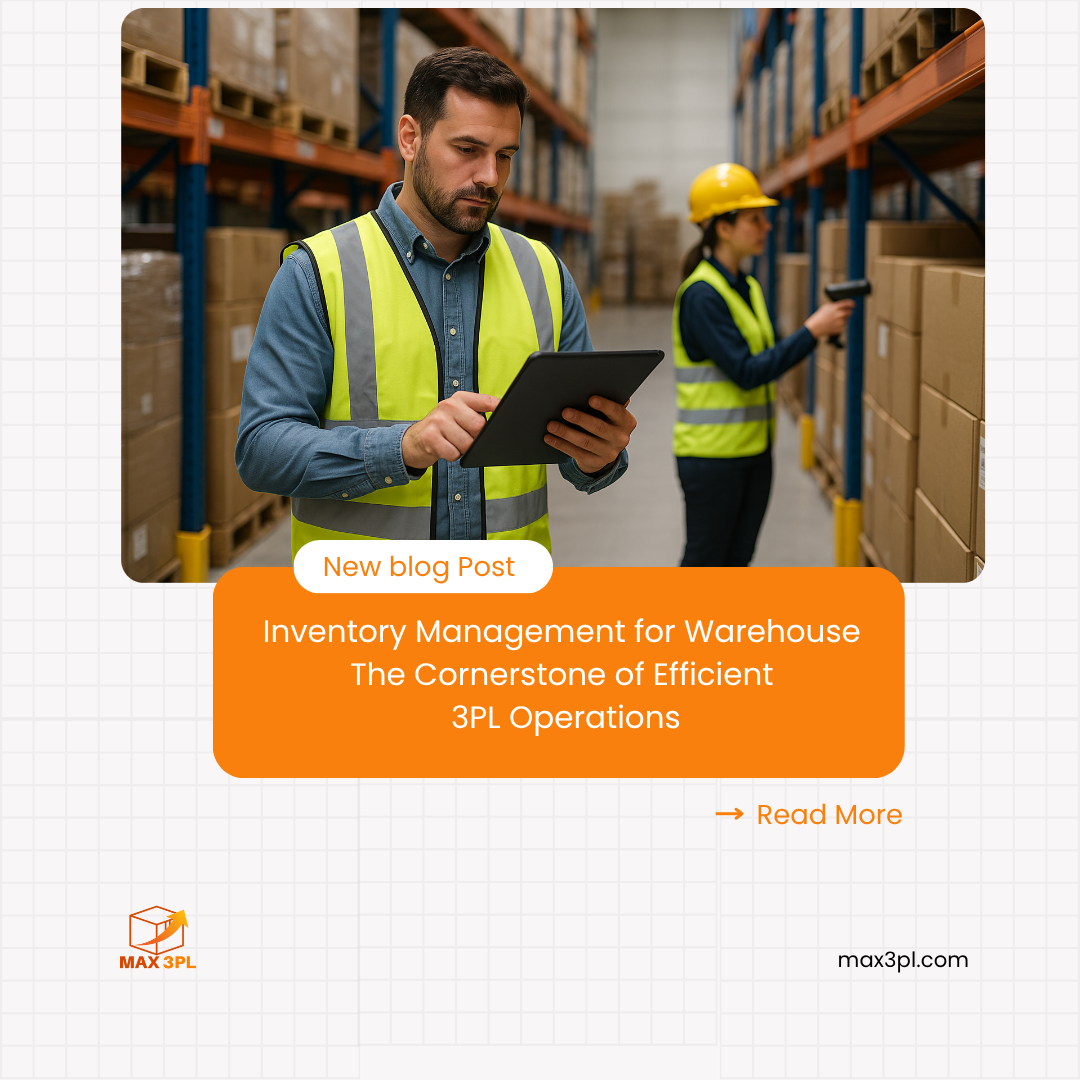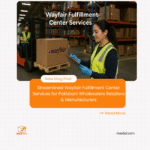In today’s fast-paced world of global eCommerce and logistics, inventory management plays a crucial role in the success of every business that sells, ships, or stores physical products. Whether you’re an online seller, a wholesaler, or a manufacturer, maintaining accurate control over inventory within your warehouse operations determines how efficiently your supply chain runs.
For Pakistani entrepreneurs expanding into the U.S. market, this process can seem complex — managing product movement, stock levels, and deliveries across multiple channels. That’s where Max 3PL, a professional third-party logistics and fulfillment partner, comes in.
At Max 3PL, we specialize in smart, technology-driven warehouse management and fulfillment services designed to simplify inventory control, reduce costs, and enhance customer satisfaction. Our mission is to empower businesses from Pakistan and beyond to compete globally — by offering world-class logistics infrastructure right in the United States.
This in-depth article explores everything you need to know about inventory management for warehouses, why it’s essential for modern business success, and how Max 3PL helps companies master it.
-
What is Inventory Management?
Inventory management refers to the systematic control, organization, and supervision of goods that enter, stay, and leave a warehouse. It includes tracking products from suppliers to storage, and from storage to customers, while maintaining real-time accuracy of stock levels.
In simpler terms — it’s knowing exactly what you have, where it is, and when you’ll need more.
Efficient inventory management ensures that businesses can:
- Meet customer demand on time
- Avoid stockouts and overstocking
- Reduce warehouse costs
- Improve cash flow
- Increase operational visibility and performance
For companies utilizing 3PL (Third-Party Logistics) partners like Max 3PL, it’s the backbone of seamless order fulfillment.
-
Why Inventory Management Matters for 3PL and eCommerce
The rise of online marketplaces such as Amazon, eBay, Shopify, Walmart, and Wayfair has completely changed how businesses handle inventory. With thousands of SKUs, fast-moving orders, and multi-channel sales, manual tracking no longer works.
That’s why automated, data-driven inventory systems are critical.
Here’s why efficient warehouse inventory management is vital:
- Customer Satisfaction: Accurate stock levels ensure that customers get their orders delivered on time.
- Cost Optimization: Reduces waste, minimizes overstocking, and prevents lost revenue from unsold items.
- Faster Fulfillment: Streamlines order picking, packing, and shipping.
- Business Intelligence: Real-time analytics support better forecasting and smarter purchasing decisions.
- Integration: Syncs with online stores and marketplaces for automatic stock updates.
At Max 3PL, we use cloud-based warehouse management systems (WMS) that seamlessly integrate with major marketplaces — helping clients maintain total control over their inventory no matter how fast they grow.
-
The Core Processes in Warehouse Inventory Management
Inventory management in a warehouse setting involves multiple steps, each requiring precision and coordination.
- Receiving Goods
Incoming stock must be verified, labeled, and entered into the inventory system. This ensures accurate counts and traceability from the start.
- Storage Organization
Products are categorized and stored efficiently using location codes, shelves, or bins. A logical layout enhances space utilization and accessibility.
- Inventory Tracking
Modern warehouses employ barcoding, RFID, and IoT technologies for real-time monitoring of every product’s location and movement.
- Picking and Packing
When orders are placed, items are picked from storage based on SKU, packed securely, and prepared for shipment.
- Shipping and Distribution
Goods are shipped through optimized routes using trusted courier networks to ensure fast and safe delivery.
- Returns and Reverse Logistics
Returned products are inspected, re-stocked, or disposed of systematically to maintain inventory accuracy.
At Max 3PL, each of these processes is managed using integrated digital tools, eliminating errors and maximizing warehouse productivity.
-
Inventory Management Systems (WMS): The Digital Heart of Modern Warehousing
A Warehouse Management System (WMS) is the technological core of efficient inventory operations. It manages everything — from receiving stock to final delivery.
Key Features of WMS used by Max 3PL:
- Real-time inventory visibility
- Automated stock updates across multiple sales channels
- Barcode & RFID integration
- Batch, serial, and lot tracking
- Automated reorder alerts
- Analytics and forecasting dashboards
With WMS integration, Max 3PL helps businesses eliminate manual errors, reduce time waste, and gain total control of warehouse performance.
-
Inventory Management Techniques for Efficiency
Different strategies suit different businesses. Here are proven inventory management methods used by successful 3PL providers and sellers:
- FIFO (First-In, First-Out)
Older inventory is sold first. Ideal for perishable or date-sensitive items.
- LIFO (Last-In, First-Out)
Newest stock is shipped first. Effective in non-perishable goods where prices fluctuate.
- Just-In-Time (JIT)
Stock is replenished only when needed — minimizing storage costs but requiring strong supplier coordination.
- ABC Analysis
Products are classified by importance:
- A: High-value items with low quantity
- B: Moderate value and quantity
- C: Low-value, high-volume items
- Safety Stock Management
Maintaining a buffer to prevent stockouts due to demand spikes or shipping delays.
- Reorder Point (ROP)
Automated triggers that reorder stock when levels drop below a threshold.
Max 3PL implements these strategies depending on client needs, helping optimize stock flow and minimize unnecessary expenses.
-
Common Challenges in Warehouse Inventory Management
Even the most advanced systems face operational challenges. The most frequent issues include:
- Inaccurate stock records
- Overstocking or understocking
- Misplaced items or poor space utilization
- Lack of real-time visibility
- Inefficient order picking
- High returns and damaged goods
How Max 3PL Solves Them
- Cloud-based real-time updates
- Scalable warehouse design
- Trained logistics teams
- Automated scanning and error reduction systems
- Seamless communication with suppliers and clients
These solutions ensure smooth operations, no matter how complex the logistics chain becomes.
-
Benefits of Effective Inventory Management
Efficient inventory management transforms warehouse performance and business growth.
Key Benefits:
- Reduced Costs: Less overstocking and wasted storage.
- Better Accuracy: Real-time stock tracking and automated systems.
- Improved Space Utilization: Organized layout and smarter storage techniques.
- Faster Fulfillment: Orders processed and delivered more quickly.
- Higher Customer Satisfaction: Fewer errors, better reliability.
- Scalability: Systems adapt as business volume grows.
For businesses aiming to expand globally, these benefits translate into competitive advantage — something Max 3PL provides to every client.
-
Technology in Modern Inventory Management
Today’s warehouses are powered by technology. The integration of automation, analytics, and AI has made inventory handling more precise than ever.
Top Technologies Used by Max 3PL:
- IoT Sensors – Monitor goods and environmental conditions.
- RFID Tags – Track real-time product movement.
- Artificial Intelligence (AI) – Predict demand and optimize stock levels.
- Cloud-Based Dashboards – Provide 24/7 remote access to stock data.
- Automated Picking Systems – Reduce time and labor costs.
By embracing innovation, Max 3PL ensures efficiency, transparency, and reliability at every stage of warehouse operations.
-
Data Analytics and Forecasting in Inventory Control
Data-driven decisions make inventory smarter.
Using analytics and forecasting, Max 3PL helps clients anticipate trends, manage seasonal demand, and plan replenishment effectively.
Examples:
- Predict which SKUs will run low soon.
- Identify slow-moving items.
- Adjust inventory levels based on market fluctuations.
This not only boosts efficiency but also enhances profitability.
-
How Inventory Management Impacts Customer Satisfaction
Customers expect accuracy and speed. When inventory management is precise:
- Orders are fulfilled without delay.
- Products are always in stock.
- Returns are processed quickly.
Every successful delivery builds trust and loyalty. Max 3PL’s streamlined processes ensure brands maintain a strong reputation through reliable fulfillment.
-
Sustainable Warehouse Inventory Practices
Sustainability is now a key priority in logistics. Efficient inventory management supports eco-friendly operations by:
- Reducing waste from overproduction.
- Using smart packaging solutions.
- Optimizing transportation routes to minimize emissions.
- Employing energy-efficient warehouse systems.
Max 3PL integrates green practices into its logistics strategy, promoting both operational efficiency and environmental responsibility.
-
The Future of Inventory Management
The next era of warehousing will be driven by automation, AI, and smart analytics.
Future trends include:
- Autonomous robots for picking and sorting.
- Predictive inventory replenishment using machine learning.
- Blockchain-based transparency in supply chains.
- Augmented Reality (AR) for warehouse navigation.
- Micro-fulfillment centers for ultra-fast local deliveries.
By staying ahead of these trends, Max 3PL continues to empower Pakistani businesses expanding into international markets with futuristic logistics solutions.
-
Why Choose Max 3PL for Warehouse Inventory Management
Here’s why Max 3PL stands out:
- Advanced cloud-based inventory systems
- U.S.-based warehouses and fulfillment centers
- Integration with Amazon, Walmart, Shopify, Wayfair, and more
- Tailored solutions for Pakistani sellers, manufacturers, and wholesalers
- Dedicated logistics professionals ensuring accuracy and speed
Max 3PL is not just a warehouse — it’s your strategic logistics partner helping you scale confidently in the U.S. market.
Conclusion
Effective inventory management for warehouses is the foundation of successful logistics and fulfillment.
By combining technology, data, and expertise, businesses can streamline their supply chains, reduce costs, and exceed customer expectations.
For Pakistani entrepreneurs, wholesalers, and manufacturers, partnering with Max 3PL means gaining a trusted ally that manages everything — from inventory storage and tracking to order fulfillment and last-mile delivery.
At Max 3PL, we don’t just move products; we move progress.
Because when your inventory is managed right — your business grows right.













Leave a Reply